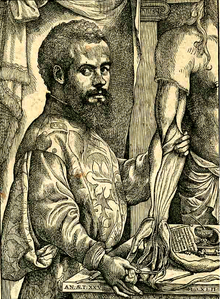Andreas Vesalius
Andreas Vesalius | |
|---|---|
 A portrait of Vesalius from De humani corporis fabrica | |
| Born | 31 December 1514 |
| Died | 15 October 1564 (aged 49) |
| Alma mater | University of Pavia University of Padua |
| Known for | De humani corporis fabrica or "the structure of the human body" |
| Scientific career | |
| Fields | Anatomy |
| Thesis | Paraphrasis in nonum librum Rhazae medici Arabis clarissimi ad regem Almansorem, de affectuum singularum corporis partium curatione (1537) |
| Doctoral advisor | Johannes Winter von Andernach Gemma Frisius |
| Doctoral students | Matteo Realdo Colombo |
| Influences | Galen Jacques Dubois Jean Fernel |
| Influenced | Gabriele Falloppio |
Andreas Vesalius (31 December 1514 – 15 October 1564) was a Flemish anatomist, physician, and author. He wrote one of the most influential books on human anatomy, De humani corporis fabrica (On the Fabric of the Human Body).[1] Vesalius is often called the founder of modern human anatomy. Vesalius is the Latinized form of Andries van Wesel. He is sometimes also called Andreas Vesal, André Vesalio and Andre Vesale.
Anatomies had been published before, but those of Vesalius were in a different class. They were based on actual dissections of human bodies (after death). And the drawings were artwork of the highest class.
Dissections of cadavers (dead human bodies) was forbidden for many centuries, and this limited previous work on anatomy. Before Vesalius, most information about the human body came from Galen. By dissecting human bodies, Vesalius showed that many of the things Galen wrote about were wrong. Galen was primarily misinformed about the human heart, liver and lower jaw bone. It was found that Galen's work was based on Barbary apes, but he also dissected pigs, which led to even more inaccurate observations.
Vesalius was invited to be the Imperial physician of Emperor Charles V. After the abdication of Emperor Charles V he continued at court in great favour with the Emperor's son Philip II.
References
- ↑ Saunders, JB de CM and O'Malley, Charles D. 1973. The illustrations from the works of Andreas Vesalius of Brussels. New York: Dover.